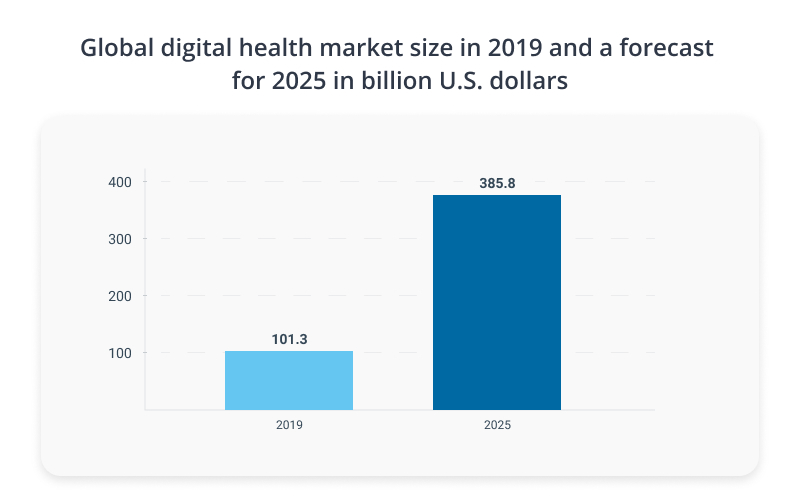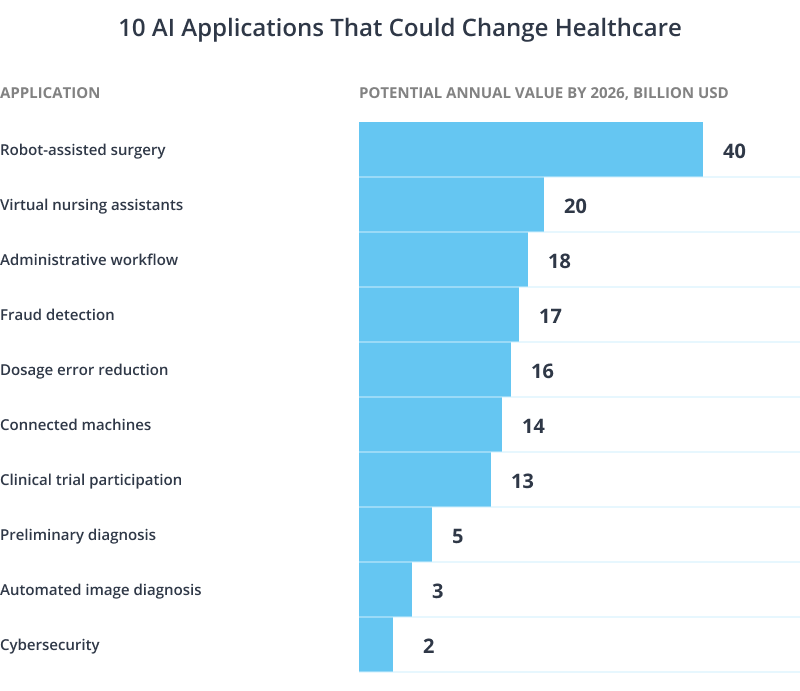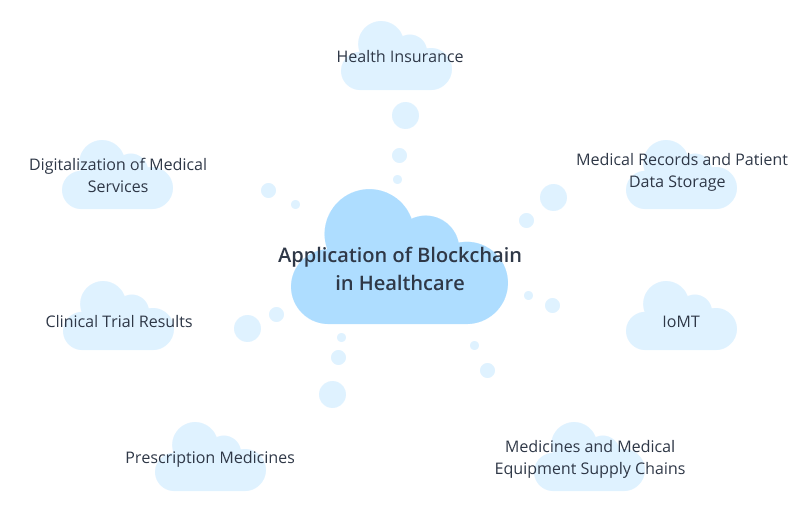Reading time:
Even before the pandemic, the medical field has been attracting investors from many domains including banks, IT giants, and retailers. However, due to the pandemic, the urgency of investing in medicine has increased. New needs have emerged for the remote monitoring of patients, “second opinions” from doctors, advanced medicine and treatment, and higher efficiency in medical institutions.
The global digital health market is projected to reach USD 385.8 billion by 2025 from an estimated market size of USD 101.3 Billion in 2019, with a CAGR of 24.6% during the forecast period.

Source: Valuates Reports
We, at Azoft, have been developing solutions for medicine for over 10 years. Keep reading to learn about what we believe are the most relevant MedTech trends.
Telemedicine
The ongoing pandemic encourages healthcare providers around the world to use telemedicine solutions. What used to be a niche solution is becoming one of the most sought-after and promising trends, and it’s definitely here to stay.
The global investment in telemedicine projects in the first quarter of 2020 increased 3.6 times compared to the same period last year, up to $788 million against $220 million. Experts from VEB Ventures predict that by 2026 the global telemedicine market will grow from $45 billion to $175 billion, with an average growth rate of 19.3% per year.
Aside from the pandemic, telemedicine growth is driven by the need to monitor patients with chronic diseases, provide services to remote areas (especially highly specialized specialists), and improve the legal framework for remote medical care.
At Azoft, we also see the significance and prospects of this area and are developing our own solutions for telemedicine:
- an application for doctors and clinics that helps conduct video and chat consultations with patients, automate payments for teleconsultations, set up analytics and add integration with the MIS clinic
- an application that allows users to store important medical documents, receipts, results and calculate the amount of tax deduction for treatment
Artificial intelligence
Artificial intelligence (AI) is one of the most promising technologies in medical tech. AI services can:
- improve diagnostic accuracy;
- automate the doctor’s work;
- choose the best treatment method;
- create new drugs, etc.
Also, artificial intelligence helps fight COVID-19. It is used to identify foci of infection, develop vaccines, and analyze computed tomography.
Next, we will talk about several key areas for the application of AI in medicine.
Patient data analysis
Before diagnosing and prescribing treatment, doctors study a lot of data about the patient: pictures, assessments, examination protocols, history, etc. Most often, the data is not systematized. Because of this, sometimes even experienced doctors cannot see the full picture of the disease. With the help of artificial intelligence, however, doctors can quickly and accurately diagnose patients.
Perhaps the largest and most talked-about use case of AI in medicine is the cognitive system, IBM’s Watson, which helps make an accurate diagnosis and find an effective treatment method for each patient. Also, Microsoft launched its AI for Health program, which is investing $40 million into artificial intelligence technologies for the healthcare sector.
Diagnostics
Another promising area of AI application is the analysis of medical images (X-ray, MRI, ultrasound, etc.). Artificial intelligence is trained to recognize the symptoms of malignant neoplasms, and also diagnose visual impairments, tuberculosis, and impaired brain function. Technologies have achieved obvious success in this area and have therefore been introduced into clinical practice.
An example of such a solution is our AI algorithm, which determines whether patients have lung cancer based on computed tomography (CT). It helps doctors diagnose the disease faster, and reduces the possibility of mistakes.
Virtual doctors
Virtual assistants are also gaining popularity. They diagnose patients, fill out medical records for doctors, and are also able to provide consultations. At Azoft, we are also working in this direction; we are developing a virtual doctor with artificial intelligence, who supports patients 24/7 and refers them to the necessary specialist in case of emergency.
These are just a few examples, which only give you a small idea of how AI can be used in healthcare. In addition, experts identify the following promising areas for the use of AI in healthcare:

Source: Accenture
Security and confidentiality of information / Blockchain
Traditional mechanisms for the exchange of health information are no longer effective in the modern health care infrastructure.
In most cases, the patient must bring all of their past medical records to the new hospital on their own or have their medical tests done again. Apart from the obvious inconvenience, the lack of a patient’s medical history can lead to inappropriate treatment.
Another problem is the lack of comprehensive information about the patient and his medical history. Incomplete patient data may be stored in the databases of various hospitals.
Blockchain is increasingly being used to solve these problems. This technology offers new approaches to data storage and management models used in many healthcare applications today. This is due to the ability of blockchain to segment and protect information and to exchange medical data and services in an unprecedented manner.
Today blockchain is used in medicine in the following areas:

MedRec, a joint blockchain project between MIT Media Lab and Israel’s Beth Israel Deaconess Medical Center, helps patients control their medical data. Patients can choose who can access the information.
The AP Information Collaboration Hub for Life Sciences allows US consumers to check the product code, batch, expiration date and unique serial number against manufacturer data stored on the blockchain.
Data integrity, security, availability and portability were in high demand during the 2020’s COVID-19 health crisis. Blockchain is an important technology that can help provide these features to allow healthcare providers to communicate effectively and remotely with COVID-19 patients.
IoT
Internet of Things (IoT) technologies are becoming useful assistants to the healthcare system. This was made even more clear by the pandemic. Over the next five years, the healthcare-related IoT market will more than double to reach over $135 billion.
Below are some use cases for IoT sensors.
Ensuring device availability
Like all electronic devices, there are some risks in the application of medical devices, from power outages to system failures, that can be a matter of life or death. A Philips IoT solution, called e-Alert, addresses this problem. Instead of waiting for a device to fail, Philips’ system monitors medical equipment and alerts hospital staff in advance if a problem occurs.
Chronic disease treatment
Fitbit smartwatches self-track chronic diseases and automatically connect patients with medical trainers and doctors.
Additionally, IoT sensors help us remotely monitor the condition of patients, make medical procedures more efficient and safe, and carry out internal processes invisible to visitors. For example, allocating beds or keeping things clean.
Robotization
The first medical robots helped perform surgery using robotic arm technology. Over time, artificial intelligence, machine learning, and computer vision technologies have expanded the capabilities of robots.
Now, robots are helping healthcare workers. For example, during the COVID-19 pandemic, robots prepare patient rooms and limit the number of personal contacts in infectious disease wards. AI robots can quickly identify drugs and distribute them to patients in hospitals.
In the future, robots will work more and more independently, in some cases performing certain tasks on their own. As a result, the quality of health care workers’ services will be significantly higher.
VR
VR technologies have gone far beyond the entertainment industry with applications in many other areas, including medicine. According to the forecast of the research and consulting company IndustryARC, by 2020 the global market for virtual and augmented reality technologies in healthcare will reach $2.54 billion. They will be mainly used for the purposes of training doctors and rehabilitating patients.
VR is perfect for training surgeons and allowing them to have experience and an excellent understanding of complex processes. For example, an orthopedic surgeon developed the Osso VR platform, which enables hands-on training in surgical procedures and also includes modules to assess the trainee’s knowledge of steps, level of accuracy and overall effectiveness throughout the procedure.
Virtual reality is also used in the rehabilitation of musculoskeletal injuries, adaptation after a stroke, and the fight against phobias.
The pandemic has become a powerful driver for the development of medical technology. Companies around the world are using modern technologies to improve the efficiency of healthcare workers as well as remote patient care and to develop medical devices that save lives every day.
Are you planning on taking advantage of the capabilities of Medicine technologies and developing your own medical solution? Leave a request for a free consultation, we’ll gladly discuss your project with you.



Comments